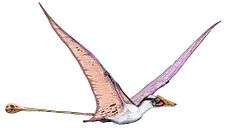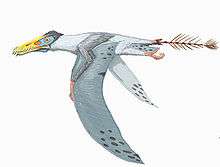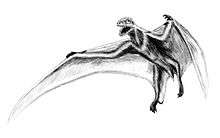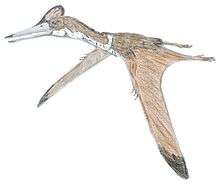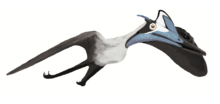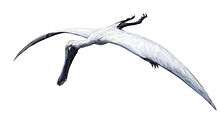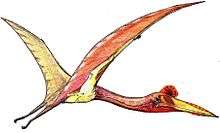Lonchodectidae
Lonchodectidae is a group of pterosaurs within the clade Pterodactyloidea. It has variously been considered to be within Ctenochasmatoidea,[1] Azhdarchoidea[2] and Pteranodontia.[3][4][5] They are notable for their high, conical tooth sockets and raised alveolar margins.[6]
| Lonchodectids | |
|---|---|
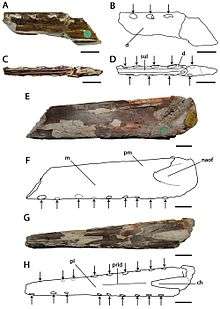 | |
| Material referred to Lonchodectes | |
| Scientific classification | |
| Kingdom: | Animalia |
| Phylum: | Chordata |
| Order: | †Pterosauria |
| Suborder: | †Pterodactyloidea |
| Clade: | †Ornithocheiromorpha |
| Family: | †Lonchodectidae Hooley, 1914 |
| Genera | |
| Synonyms | |
| |
Taxonomic history

Lonchodectidae was first named by paleontologist Reginald Walter Hooley in 1914,[7] and was first considered to only contain species of Lonchodectes.[8] A taxonomic review of pterosaurs from the Cambridge Greensand in 2013 considered Lonchodectes a nomen dubium, and named a new family, Lonchodraconidae, for the remaining species, which had been moved to the new genus Lonchodraco.[9] Yixianopterus,[10] Unwindia, Prejanopterus,[11] and Serradraco[12] have also been considered possible lonchodectids. A taxonomic review of Lonchodectidae by Russian paleontologist Alexander Averianov in 2020 limited the clade to Ikrandraco, Lonchodectes, and Lonchodraco, thus finding Lonchodraconidae to be synonymous with the earlier name Lonchodectidae.[5]
Description
The most diagnostic features of Lonchodectidae pertain to the teeth and jaws. The teeth on both the upper and lower jaws are generally small, do not vary in size through the length of the jaw, and are placed on raised alveolar margins. The upper palate has a prominent ridge. One genus, Lonchodraco, has prominent crests at the tips of both the skull and mandible, while another, Ikrandraco, only has a crest on the mandible. Only Lonchodraco and Ikrandraco preserve postcrania, which is similar to other lanceodontians.[5]
Classification
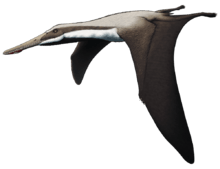
The cladogram below is a topology recovered by Longrich and colleagues in 2018. In their analysis, they placed the family Lonchodectidae as the sister taxon of the family Boreopteridae, while also placed within the more inclusive group Ornithocheiromorpha.[13]
| Ornithocheiromorpha |
| |||||||||||||||||||||||||||||||||||||||||||||||||||||||||||||||
Paleobiology
Lifestyle
Postcranial material similar to those of azhdarchoids has previously been referred to Lonchodectes;[14] however, this material has later been referred to the azhdarchoid Ornithostoma.[15] Ikrandraco is presumed to have been piscivorous, though this is not completely confirmed.[16]
References
- Unwin, David M. (2003). "On the phylogeny and evolutionary history of pterosaurs". In Buffetaut, Eric; Mazin Jean-Michel (eds.). Evolution and Palaeobiology of Pterosaurs. Geological Society Special Publication 217. London: Geological Society. pp. 139–190. ISBN 1-86239-143-2.
- Unwin, D.M. (2008)
- Witton, M.P., Martill, D.M., and Green, M. (2009). "On pterodactyloid diversity in the British Wealden (Lower Cretaceous) and a reappraisal of “Palaeornis” cliftii Mantell, 1844." Cretaceous Research, 30: 676–686.
- Andres, B.; Myers, T. S. (2013). "Lone Star Pterosaurs". Earth and Environmental Science Transactions of the Royal Society of Edinburgh: 1. doi:10.1017/S1755691013000303.
- Averianov, A.O. (2020). "Taxonomy of the Lonchodectidae (Pterosauria, Pterodactyloidea)". Proceedings of the Zoological Institute RAS. 324 (1): 41–55. doi:10.31610/trudyzin/2020.324.1.41.
- Pterosaurs: Natural History, Evolution, Anatomy, Mark P. Witton (2013)
- Hooley, R.W. 1914. "On the Ornithosaurian genus Ornithocheirus with a review of the specimens from the Cambridge Greensand in the Sedgwick Museum, Cambridge", Annals and Magazine of Natural History, series 8, 78: 529-557
- Unwin, David M. 2001. "An overview of the pterosaur assemblage from the Cambridge Greensand (Cretaceous) of Eastern England". Mitteilungen as dem Museum für Naturkunde, Berlin, Geowissenschaftliche Reihe 4: 189–222
- Rodrigues, T.; Kellner, A. (2013). "Taxonomic review of the Ornithocheirus complex (Pterosauria) from the Cretaceous of England". ZooKeys. 308: 1–112. doi:10.3897/zookeys.308.5559. PMC 3689139. PMID 23794925.
- J. Lü, S. Ji, C. Yuan, Y. Gao, Z. Sun and Q. Ji. 2006. New pterodactyloid pterosaur from the Lower Cretaceous Yixian Formation of Western Liaoning. Papers from the 2005 Heyuan International Dinosaur Symposium. Geological Publishing House, Beijing 195-203
- Witton, Mark P. (2013). Pterosaurs: Natural History, Evolution, Anatomy
- Rigal, S.; Martill, D. M.; Sweetman, S. C. (2017). "A new pterosaur specimen from the Upper Tunbridge Wells Sand Formation (Cretaceous, Valanginian) of southern England and a review of Lonchodectes sagittirostris (Owen 1874)". Geological Society, London, Special Publications: SP455.5. doi:10.1144/SP455.5.
- Longrich, N.R., Martill, D.M., and Andres, B. (2018). "Late Maastrichtian pterosaurs from North Africa and mass extinction of Pterosauria at the Cretaceous-Paleogene boundary." PLoS Biology, 16(3): e2001663. doi:10.1371/journal.pbio.2001663
- Pterosaurs: Natural History, Evolution, Anatomy, Mark P. Witton (2013)
- Averianov, A.O. (2012). "Ornithostoma sedgwicki – valid taxon of azhdarchoid pterosaurs." Proceedings of the Zoological Institute RAS, 316(1): 40–49.
- Xiaolin Wang; Taissa Rodrigues; Shunxing Jiang; Xin Cheng; Alexander W. A. Kellner (2014). "An Early Cretaceous pterosaur with an unusual mandibular crest from China and a potential novel feeding strategy". Scientific Reports. 4: Article number 6329. doi:10.1038/srep06329. PMC 5385874. PMID 25210867.
